Top speed 1,030 km/h Length 9.7 m Retired 1962 First flight September 2, 1949 | Wingspan 13 m Introduced 1952 Engine type de Havilland Ghost | |
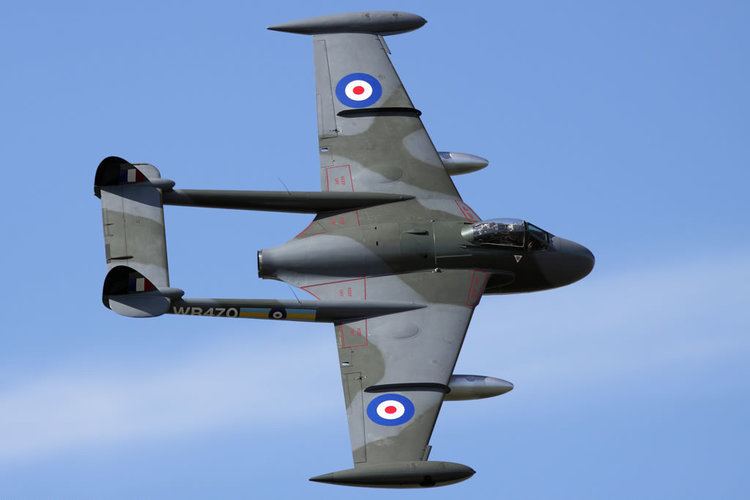 | ||
De havilland venom 1950s jet fighter bomber
The de Havilland DH 112 Venom was a British postwar single-engined jet aircraft developed from the de Havilland Vampire. It served with the Royal Air Force as a single-seat fighter-bomber and two-seat night fighter. The Venom was an interim between the first generation of British jet fighters – straight-wing aircraft powered by centrifugal flow engines such as the Gloster Meteor and the Vampire and later swept wing, axial flow-engined designs such as the Hawker Hunter and de Havilland Sea Vixen. The Venom was exported to Iraq, New Zealand, Sweden, Switzerland and Venezuela.
Contents
- De havilland venom 1950s jet fighter bomber
- Rc ready2fly de havilland venom dh 112
- Design and development
- Operational history
- Variants
- Operators
- Surviving aircraft
- Specifications Venom FB 1
- References
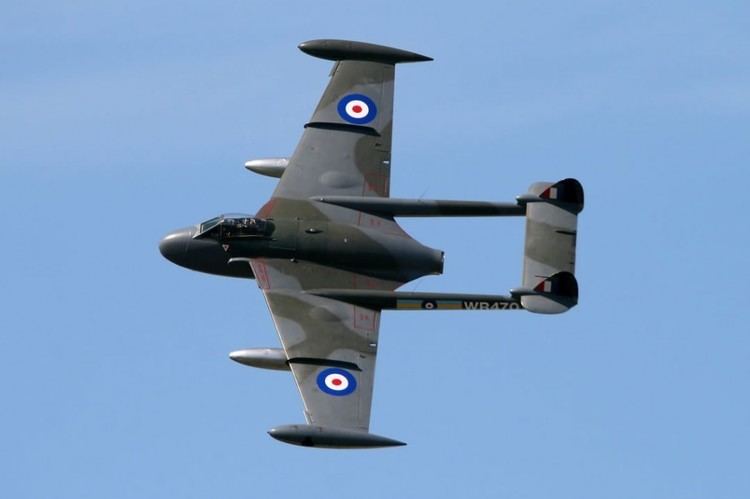
The Sea Venom was a navalised version for carrier operation.
Rc ready2fly de havilland venom dh 112
Design and development
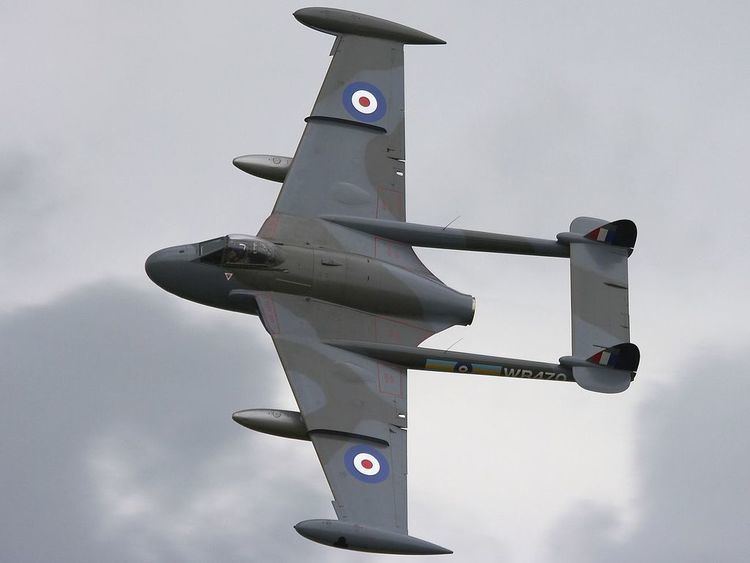
The Venom was produced as a successor to the Vampire, which had been the second jet aircraft to enter service with the RAF. In 1948, de Havilland proposed a development of the Vampire with a thin wing and more powerful engine as a high altitude fighter, the Vampire FB 8. Although generally similar in appearance to the Vampire, sharing the distinctive twin-boom tail and composite wood/metal structure, the Venom was a completely new design. The proposal was adopted and a Vampire F 1 was converted by fitting the new de Havilland Ghost engine, which was more powerful than the de Havilland Goblin used on the Vampire. As the DH 112, the Venom filled an Air Ministry requirement for a fast, manoeuvrable and capable fighter-bomber to replace the Vampire.
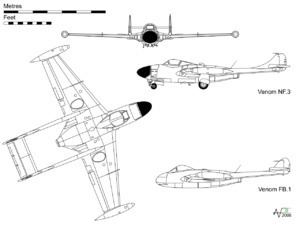
The first Venom prototype flew on 2 September 1949, and the first Venom variant, a single-seat fighter-bomber, entered service in 1952 as the FB 1. 375 were built. The F.B.1 was armed with four 20 mm (.79 in) Hispano Mk V autocannons in the nose and could carry either two 1,000 lb (approx 450 kg) bombs or eight RP-3 60 lb (27 kg) air-to-ground rocket projectiles – the heavier bombs being an improvement over the Vampire FB 5. It was powered by a single 4,850 lbf (21.6 kN) thrust Ghost 48 Mk.1 engine.
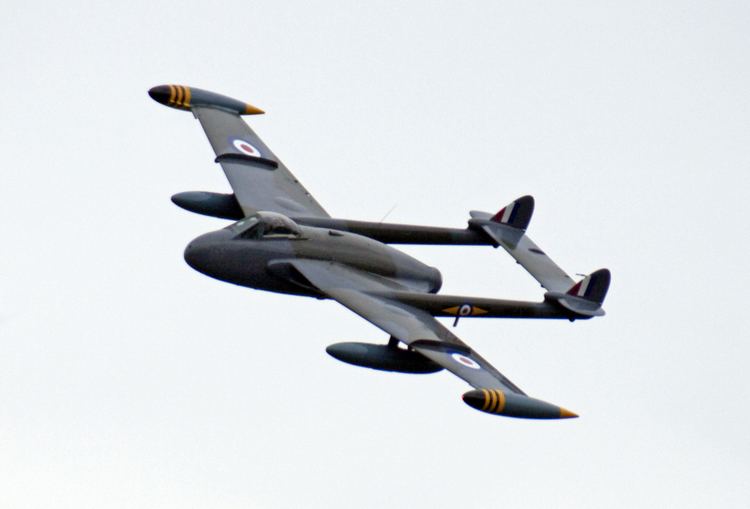
The next Venom, the NF.2 night fighter, first flew on 22 August 1950 and entered service in 1953, after being delayed with minor problems. The fuselage was redesigned to accommodate a two-man crew (pilot and navigator/radar operator), seated side-by-side, and an airborne interception radar installed in the nose. It replaced the Vampire NF 10, and was followed by the NF 3, the last night fighter variant of the Venom, which first flew in 1953 and entered service in 1955. The night fighter Venom had a relatively brief career with the Royal Air Force, as it was only an interim solution, and was withdrawn in 1957 and replaced by the Gloster Javelin twin-engined all-weather fighter.
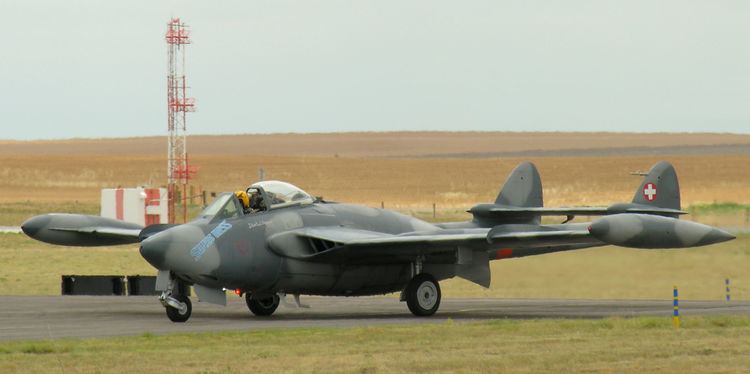
The final Venom for the RAF was the single-seat FB.4 which first flew on 29 December 1953. It entered service in 1955 and 250 were built. It was powered by a single 4,850 lbf (21.6 kN) thrust de Havilland Ghost 103 turbojet engine. It was the first Venom to be fitted with an ejector seat and also had redesigned tail surfaces and powered ailerons.
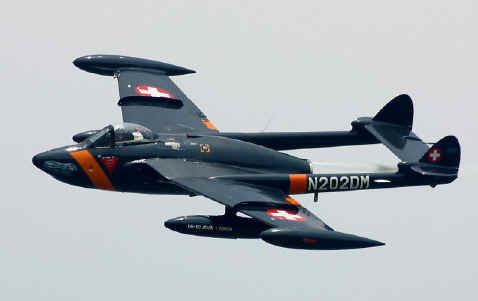
Main production of the Venom was by de Havilland, augmented by numbers of FB.1, FB.4 and NF.51 built by Fairey Aviation at Manchester (Ringway) Airport.
Operational history
The RAF fighter-bomber Venoms saw service during the Malayan Emergency which took place between 1948 and 1960, although they did not begin operations until the mid-1950s with Nos. 45 and 60 Squadrons RAF. While there, the Venom supported operations against Communist guerrillas as part of Operation Firedog, the codename for Royal Air Force operations in Malaya. Venoms were lent to the Royal New Zealand Air Force for use in the same conflict where they operated with No. 14 Squadron RNZAF.
The Venom also saw service during the Suez Crisis being operated by Nos. 6, 8 and 249 Squadrons RAF flying from RAF Akrotiri, Cyprus. The Anglo-French invasion, codenamed Operation Musketeer, took place in response to the nationalisation of the Suez Canal by Egypt's leader, General Nasser. The air war began on 31 October 1956 signalling the beginning of the Suez War. The Venoms launched a number of sorties, attacking a variety of military installations on the ground. They also saw action in the Middle East, supporting operations against terrorists in Aden and Oman, losing some aircraft in the process. Venoms additionally saw service during the Mau Mau insurgency in Kenya.
All Venoms in RAF service were withdrawn from first-line service in 1962, having proven their worth in a variety of locations across the world, in peace and war, and in some of the most difficult climates the RAF has ever faced. The last non-RAF Venoms to leave active service were Swiss Air Force Venoms which retired in 1983. About 20 Venoms continue to fly as of 2004, performing at various air shows, while a number of examples are preserved in museums in the United Kingdom and abroad, in non-flying, static display condition.
Variants
Operators
Surviving aircraft
The Venom has been preserved in significant numbers, thanks in part to its longevity with the Swiss Air Force. In the UK, a number of Sea Venoms are preserved, along with examples of the NF 3 and Swiss-built FB.50 and 54. In Sweden, two examples of the NF.51 are preserved. There are many survivors in Switzerland, and other Swiss aircraft are scattered throughout Europe. One such aircraft is preserved in the Israeli Air Force Museum in Hatzerim, although in the colours of the Iraqi Air Force. In Australia, a number of Sea Venom FAW.53s have also survived. Venezuela has the only complete surviving British-built single-seat Venom.
Although the Venom was, for a time, a popular and cheap warbird the number of airworthy aircraft is dwindling. Currently there are two in the UK that fly regularly, along with a single example in Switzerland, that flew from 1988 until 2011, when it went to New Zealand. Another one flew in the USA. All are licence-built Swiss examples.
Specifications (Venom FB 1)
Data from Fighters of the Fifties
General characteristics
Performance
Armament
